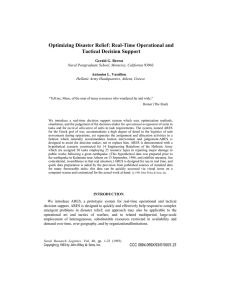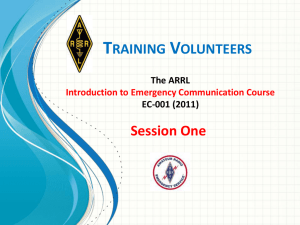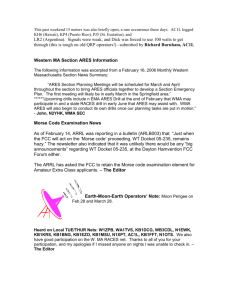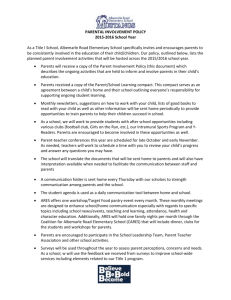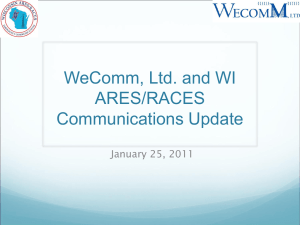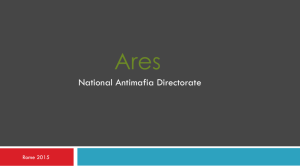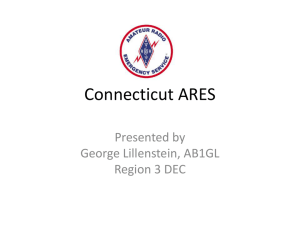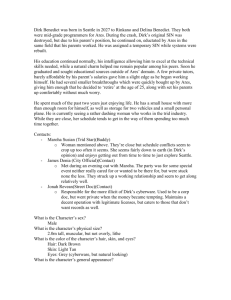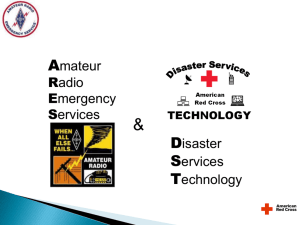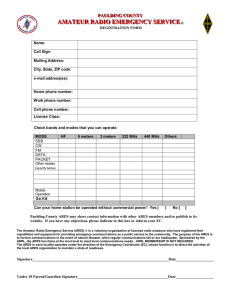Intro to EmComm and ARES Course
advertisement
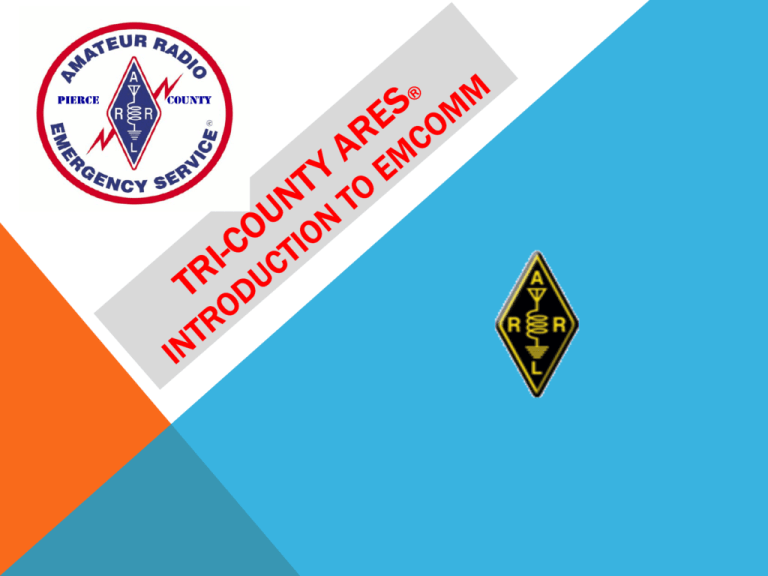
WHO ARE WE? WHAT DO WE DO? Amateur Radio Emergency Service or ARES® is an arm of the Amateur Radio Relay League (ARRL). ARES® is an organization where Amateur Radio Operators can donate their time and equipment to assist governmental agencies, non profit and public service organizations with their emergency and general communications in times of need. ARES ORGANIZATION (Elected) Eugene Clark, W4AYK SM Section Level ASM Various Asst. SM’s DEC From Surrounding Districts in Ga. EC AG4ZR David Benoist SEC DEC S.E. Nt4TH Todd Hargrave From Surrounding S.E. Counties EC Pierce KD6ZR Rick Lutzinger ? HOW WILL WE BE TRAINED? 1.Class Room Training (Right Now) 2.Online Training (FEMA Courses) 3.Practical Exercises like drills and Simulated Emergency Tests WHAT WILL OUR TRAINING CONSIST OF? Classroom Courses 1. Introduction to EmComm (This Course). 2. Communications Protocol and Net Procedures. 3. ARES Activation and Deployment. 4. Formal Message Handling. 5. Digital Communications (NBEMS). WHAT WILL OUR TRAINING CONSIST OF? Online Courses 1. Ga. Basic EmComm Course 2. FEMA IS-100.b, 200.b, 700.a, 800.b, 802 WHAT WILL OUR TRAINING CONSIST OF? Practical Exercises 1. Participate in Field Day or other remote set-up activity approved by EC. 2. Participation in an official S.E.T. 3. Participation in Pierce County simplex exercise. WHAT WILL OUR TRAINING CONSIST OF? OPTIONAL COURSES 1. Basic Skywarn Spotter 2. Advanced Skywarn Spotter WHAT WILL YOU GET WHEN YOU FINISH ALL COURSES AND ACTIVITIES? KNOWLEDGE To do your Job AND GEORGIA ARES I.D. BADGE: The following courses and conditions are required to obtain a Georgia ARES I.D. Badge: 1. Background Check: (One of the below) *Red Cross (identification or formal document). *Firearms Carry Permit (within last five years). *Background check conducted by County EMA. *County, State, or other Government agency background check documentation *Letter or statement from private or public employer involving work with children, social work, or elderly. *Letter or statement from employer (within last five years) demonstrating completion of background check. ----------------------------------------------------------------------------------------------- 2. FEMA NIMS ICS Online Training: (Must take all FEMA courses below. All courses are free) IS-100 series IS-200 series IS-700 series IS-800 series IS-802 series ---------------------------------------------------------------------------------------------3. ARES Training: (FREE online short Course) Georgia Basic Emergency Communications WHAT TO DO BEFORE YOU ARE ACTIVATED? 1. Have a plan now to take care of your family while you are away. Don’t wait until the call comes and then try and decide what your family or pets will do. 2. Have a GO-Kit ready including communication equipment and personal comfort items. 3. Have a copy of your Amateur Radio License and your ARES ID with you before you leave. 4. Monitor known net frequencies for you organization. 5. Make sure your EC has all your current contact information. HOW ARE ARES MEMBERS ACTIVATED? 1. The ARES Emergency Coordinator or his/her designee will activate members as per established local organization protocol. 2. Do not Self Deploy, wait until you are officially deployed before you leave home. We are not first responders. 3. Do listen in on established nets should an activation occur and wait to see if net control calls for check-ins. LISTEN, LISTEN, LISTEN, first. WHAT TO DO WHEN YOU ARRIVE AT YOUR DUTY STATION. 1. Report to the served agency supervisor to let them know you are there and ready when needed. 2. If a room is available and assigned to you, go there and set-up your equipment. 3. Check into the established net or nets and let net control know you are on duty. 4. Begin your duties of sending and receiving traffic as directed. WHAT NOT TO DO WHEN YOU ARRIVE AT YOUR DUTY STATION. 1. Get in the way of official business going on. 2. Stand around where you are not needed. 3. Get involved in idle chit chat with people trying to do their job. 4. Tell everyone how much you know about Amateur Radio or anything else for that matter. DRESS APPROPRIATELY When you are activated dress appropriately. Generally you should be in either business casual or clean casual. That means clothes without stains. Jeans are fine if clean and not faded or torn. Long paints are suggested for woman and men and woman may elect to wear medium or long skirts. Closed toed shoes should be worn by all. Polo shirts or button shirts are fine. Short or long sleeves are fine. The main thing here is clean, pressed and un-faded everyday clothes are fine. No shirts with advertisements unless it’s ARES, ARRL, Ham Radio etc. Example: “Joe’s Bar and Grill” would be unappropriate. ARES vests are appropriate. Appropriate hats are encouraged for outside wear. Don’t dress up. A suit and tie would be overkill in most cases and would only beg the question WHY? APPROPRIATE DRESS OR NOT? APPROPRIATE DRESS OR NOT? APPROPRIATE DRESS OR NOT? APPROPRIATE DRESS OR NOT? KNOW HOW TO SET UP A STATION. 1. Be familiar with the station you will be operating including how to set it up and make minor adjustments if necessary. Have the station pre-programmed before you activate. 2. Include a volt/ohm meter in your go kit and know how to use it. 3. A SWR meter or antenna analyzer is a plus. Everyone may not have one. If you do bring it. 4. Battery operated AM/FM radio to monitor weather conditions only!!! 5. Weather Alert Radio 6. Laptop Computer for record keeping and running digital modes. KEEP A STATION LOG? 1. Can use ICS official Station Log Form. 2. Can make your own Station Log. 3. Minimum info. to capture is: a. Message Number (If formal or provided) b. Message from c. Message to d. Time and date e. Frequency e. Body of message USE PROPER AMATEUR RADIO ETIQUETTE 1. 2. 3. 4. Send your informal messages as short and accurate as possible. Send formal written traffic exactly as written by the author. Do not editorialize (Get to the point). Do not use slang (CB Jargon) such as: a. using 10 codes or any codes for that matter. b. Saying “there” after each sentence. 4. Use your “Tactical Callsign” when answering or calling to identify your location and always sign off with your own FCC Callsign. 5. Brevity and Clarity is the key to good communications. 6. Use Standard ITU Phonetics. Example; “O” is Oscar not Ocean. Do Not Talk to the Press The press is looking for any information they can find and you will most likely know something they would like to know. It is not your role to be disseminating information to the public. There will be a Public Information Officer assigned to the event or as part of the responding agency you are serving . Refer all questions from the press and others to the event or agency to the PIO. No mater how persistent the questioner is you are not authorized to disseminate information. If they do not leave when asked, talk with your ARES or Agency management personnel and ask them to resolve the problem. 1.To send larger text files and lists. 2.When messages must be exact such as prescriptions or list’ of medicine. 3.When attachments need to be sent. 4.When error correction is needed. 5.When the recipient needs a printed copy of the exact message. Operators should become familiar with the digital mode that is used by their organization. Peirce County ARES is testing Narrow Band Emergency Messaging System (NBEMS) and expects to use it as the primary digital mode for operations. Please take some time to explore this mode and the software associated with it. Training will be provided on NBEMS to all interested members. SKILLS TO LEARN AND PRACTICE 1. Formal Message Handling (ARRL and ICS-213) 2. Digital Modes (NBEMS) 3. ITU Phonetics 4. NCS Basics 5. Hooking up an Amateur Station and checking basic parameters such as SWR, Voltage, impedance of feed line and power connections. Preparing and using Powerpole connectors. LAST BUT NOT LEAST – NEED WE SAY MORE. PIERCE COUNTY ARES® TRAINING WEB SITE: HTTP://WWW.PIERCECOUNTYARES.ORG/

